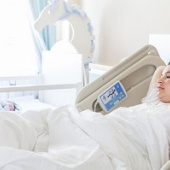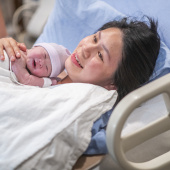Caesarean birth is when a baby is born by abdominal surgery. Some are planned, while others are unplanned or emergency caesareans.
Caesarean (sez-AIR-ee-an) birth is when a baby is born through a cut in the lower abdomen and womb instead of through the vagina.
Between 1 April 2022 and 31 March 2023, 39 in 100 births were caesarean births. This includes both planned and unplanned caesareans (NHS Digital, 2023a).
What are the kinds of caesarean birth? (NICE, 2021)
Planned, happens before labour starts
The pregnant woman or person and baby are well but the baby needs to be born early. For example, if the baby is in a transverse lie (is lying sideways).
Or the birth may be timed to suit the parent or healthcare provider, for example if the pregnant woman or person has tokophobia (fear of giving birth).
Unplanned, happens during labour
In the case of an unplanned caesarean, the pregnant woman or person, or the baby, may not be coping well and consent to the baby being born by caesarean. This might be the case if labour is not progressing. When this is the case, the baby should be born within 75 minutes. While this is unplanned, it is not an emergency.
Sometimes, there is thought to be an immediate threat to the life of the woman or pregnant person, or baby. This could be for example in the case of uterine rupture or cord prolapse. When this is the case, the baby should be born within 30 minutes. The birth partner will not be in the room.
Is it possible to ask for a caesarean birth?
Most caesarean births are offered for specific medical reasons (RCOG, 2022).
However, a caesarean birth can be requested without a medical need. The doctors and midwives must consider the request. If they are unable to support the decision, they must refer you to a team who can support it (Birthrights, no date; RCOG, 2022).
If the pregnant woman or person wants a caesarean while in labour, their request must be taken seriously (Birthrights, no date).
If a caesarean birth is preferred, tell the healthcare professional as early as possible. This will help them understand the needs of the pregnant woman or parent and support them (RCOG, 2022).
Our NCT antenatal courses provide evidence-based information on all types of birth.
What happens before a caesarean birth? (NHS, 2023a; NICE, 2021; RCOG, 2022)
- Obstetricians (ob-ste-TRISH-unz) are doctors specialising in care during pregnancy, birth and the postnatal period. They carry out caesarean births in an operating theatre in hospital. If a caesarean is planned, there will be an appointment with an obstetrician in advance to discuss the operation.
- The pregnant woman or person will be given a date for a planned caesarean, but this might change due to people with a higher need. It will usually be after 39 weeks of pregnancy.
- It is possible that labour could start before a planned caesarean. The pregnant woman or person will be told what to do if that happens.
- It will be recommended to stop eating and drinking a few hours before the operation.
- Do not remove pubic hair before surgery, as this increases the chance of wound infection (NICE, 2020).
- There will be a consent form to sign. An example for planned caesarean birth can be found on the RCOG website.
- Because of the risk of thrombosis (a blood clot), pressure stockings will be provided.
- The pregnant woman or person will be given an antacid to reduce stomach acid, and an anti-emetic to reduce nausea and vomiting.
What happens during a caesarean birth? (NICE, 2021)
- There are several medical professionals in the operating theatre. They all have a job to do and if there is time they will introduce themselves. The room is cool to minimise the chance of infectious germs.
- Depending on the urgency, the pregnant woman or birthing parent may walk into theatre with their birth partner. The father, non-birthing parent or birth partner will have changed into surgical scrubs.
- In an unplanned caesarean where doctors are very worried about the pregnant woman or parent, or baby, the birth partner remains outside. Parents tell us this can feel very difficult.
- Where possible, music preferences will be accommodated.
- Pain relief is usually either a top-up of an existing epidural, or a spinal injection. A check is made before the incision to ensure that nothing can be felt.
- In an emergency, a general anaesthetic is used. This means the pregnant woman or person is asleep during the birth.
- A thin tube called a catheter is placed in the bladder to empty it. A small area of pubic hair is trimmed.
- A screen is placed across the lower half of the pregnant woman or person's body so they won’t be able to see the surgery. If present, the birth partner sits by their head with the anaesthetist and won’t see the surgery either.
- It is common to experience cold and shivering. The health professionals should offer support.
- A 10-20cm cut is made across the tummy. This is usually a horizontal cut just below the bikini line. The baby is born through the opening.
- The pregnant woman or person may feel some tugging and pulling while it is happening. The anaesthetist will be continually checking that the pregnant person is not feeling any pain.
- The baby is born within 5-10 minutes of the cut being made. The screen can be lowered so parents see their baby as they are born. Parents can also ask for silence so that their voice is the first their baby hears. Some parents ask for the lights to be dimmed, except for the surgical light.
- The placenta is born through the same opening. Depending on the situation the pregnant woman or person may discuss their preference for the cord. See our article on birth of the placenta.
- The woman or birthing person can usually hold the baby skin-to-skin straight away. To help with skin-to-skin the surgical gown can be worn with the opening at the front. Sometimes the baby needs some medical assistance from the paediatrician (pee-dee-ah-trish-un), a doctor who specialises in babies.
- Sometimes the woman or birthing person doesn't feel able to hold their baby skin to skin. In that case, the father or non-birthing parent could hold the baby instead.
- The baby needs to be kept warm, for example by skin-to-skin contact and a blanket, or in an incubator.
- An injection of oxytocin helps the womb to contract and reduce blood loss.
- The whole procedure usually lasts about 40-50 minutes as the womb is closed with stitches which dissolve. The cut in the tummy is also closed with dissolvable stitches or ones that will be removed after a few days.
What happens immediately after a caesarean? (NICE, 2021; NHS 2023a)
- From the operating theatre, the mother or birthing parent and baby are moved to a recovery area for initial monitoring.
- Following an emergency caesarean, the baby may be brought to the recovery area to be cared for first by the father, non-birthing parent or birth partner while the mother or new parent is receiving additional care. Or they may come out together but the mother or new parent is still asleep.
- Breastfeeding can start immediately, and should be supported if desired.
- If there are no complications, then eating and drinking can resume as normal.
- The mother or birthing parent will be given painkillers to help with any abdominal pain. The catheter will be removed after 12 hours, once able to walk around.
- Healthcare staff will continue to monitor the mother or birthing parent and baby’s wellbeing, including checking for signs of infection.
- The wound dressing will be removed within 24 hours. Information will be given about how to keep the wound clean and any other signs to watch out for.
- If the caesarean was unplanned, then there should be an opportunity to discuss the reasons either before or after discharge.
- Discharge from hospital will be after 24 hours. This will be longer if the mother or birthing parent, or baby need additional support. Read about recovery from a caesarean birth.
When might a caesarean birth be offered?
A planned caesarean may be suggested if (NICE, 2021):
- the baby is in a more awkward position for vaginal birth. Read our article about baby positions in the womb
- the first baby is breech in a twin or multiple birth
- the baby has a medical condition that means vaginal birth might be challenging for them
- the placenta is near to or covering the inside of the cervix, which is known as placenta praevia or low-lying placenta
- scans show the placenta has embedded in the uterus following a previous caesarean
- the mother or birthing person has an active infection, such as genital herpes, which could be passed to the baby during a vaginal birth
- another medical condition makes this the safest option for giving birth
Sometimes, a caesarean takes place after labour has started. This could be because (NICE, 2023):
- labour is not progressing and the mother or birthing person and baby are getting tired or showing signs of distress
- an unexpected situation arises during labour, for example the baby moves into an awkward position or an assisted birth is unsuccessful
What are the benefits of a caesarean birth?
For some women and people who are pregnant, a planned caesarean might reduce the chance of (RCOG, 2022):
- feelings of anxiety about vaginal birth and loss of control
- feelings of anxiety due to historic abuse or body dysmorphia
- feelings of anxiety due to a previous traumatic birth
- having an assisted vaginal birth (with forceps or ventouse) or emergency caesarean birth
- tearing to the vagina or perineum
- urinary incontinence
What are the risks of a caesarean birth?
A caesarean birth is considered very safe. However, there are some increased risks to the parent and baby. These include (NHS, 2023; NICE, 2021; RCOG, 2022):
- a longer hospital stay and recovery time
- wound discomfort for several weeks. 1 in 10 experience discomfort for a few months.
- infection for 8 in 100 women or birthing people which can take several weeks to heal. Antibiotics are given before the operation to reduce the chance of infection.
- internal scar tissue (adhesions) which may be painful and affect future operations
- a cut to the baby’s skin during the surgery (2 in 100 babies)
- temporary breathing difficulties requiring admission to the neonatal unit are more likely for babies born before 39 weeks of pregnancy
Possible but rare risks include (NHS, 2023; RCOG, 2022):
- heavy bleeding which requires a hysterectomy (his-ter-ECTO-mee), which means a removal of the uterus (1 in 670 after caesarean birth compared with 1 in 1250 after vaginal birth)
- damage to the bladder or other internal organs
- maternal death (1 in 4,200 after caesarean birth compared with 1 in 25,000 after vaginal birth)
- higher chance of complications with the placenta in future pregnancies (1 in 1000 compared with 1 in 2500 who have a vaginal birth)
- higher chance of uterine rupture in next vaginal birth (1 in 98 compared with 1 in 2500 with no previous caesarean)
- slight increased chance of the baby developing asthma (1 in 55 compared to 1 in 67 after a vaginal birth)
- very slight increased chance of the baby becoming obese (1 in 22 compared to 1 in 25 after a vaginal birth)
- increased chance of the baby dying in the first 28 days of birth (1 in 2000 compared to 1 in 3300 after vaginal birth)
Does a caesarean birth affect breastfeeding?
Women or birthing people who labour before giving birth either vaginally or by caesarean have released hormones which support breastfeeding (Prior et al, 2012). Some studies have shown that babies who were born by caesarean are less likely to have skin-to-skin contact immediately after birth (Hobbs et al, 2016). This can affect breastfeeding.
NICE guidelines state that women and new parents should be offered skin-to-skin contact with their baby as soon as possible after birth. They should also be offered support with breastfeeding, if they would like to (NICE, 2021).
What are my rights about what kind of birth I can have?
It should always be possible to speak to a senior midwife or consultant midwife if the right information or support isn’t being given.
Their role is to listen and provide information to help make a decision. This could be for a vaginal birth or a caesarean, and either choice should be supported.
If the parent isn’t happy with the diagnosis or treatment they receive, they can ask for a second opinion. Asking for a second opinion shouldn’t negatively impact their care (The Patients Association, no date).
It’s possible to look up local rates of caesarean by searching for maternity statistics for your country.
Birthrights. (No date) Your right to a caesarean birth. https://www.birthrights.org.uk/factsheets/right-to-a-c-section/ [11 Sep 24]
Carlhäll, S., Nelson, M., Svenvik, M. et al. (2022) Maternal childbirth experience and time in labor: a population-based cohort study. Sci Rep 12, 11930. https://doi.org/10.1038/s41598-022-14711-y
Coates D, Thirukumar P, Henry A. (2020) Women’s experiences and satisfaction with having a cesarean birth: An integrative review. Birth. 47: 169–182. https://doi.org/10.1111/birt.12478
Coates, D., Donnolley, N., Thirukumar, P., Lainchbury, A., Spear, V. and Henry, A. (2021), Women’s experiences of decision-making and beliefs in relation to planned caesarean section: A survey study. Aust N Z J Obstet Gynaecol, 61: 106-115. https://doi.org/10.1111/ajo.13255
Grisbrook M-A, Dewey D, Cuthbert C, McDonald S, Ntanda H, Giesbrecht GF, Letourneau N. (2022) Associations among Caesarean Section Birth, Post-Traumatic Stress, and Postpartum Depression Symptoms. International Journal of Environmental Research and Public Health. 19(8):4900. https://doi.org/10.3390/ijerph19084900
Hobbs A, Mannion C, McDonald S, Brockway M, Tough S. (2016) The impact of caesarean section on breastfeeding initiation, duration and difficulties in the first four months postpartum. BMC Pregnancy and Childbirth. 16:90. https://doi.org/10.1186/s12884-016-0876-1
NHS (2023a) Caesarean section: Overview. https://www.nhs.uk/conditions/caesarean-section/ [6 Nov 24]
NHS (2023b) Caesarean section: What happens. https://www.nhs.uk/conditions/caesarean-section/what-happens/ [6 Nov 24]
NHS Digital (2023) NHS Maternity statistics, England, 2022-23. Summary report tables.xls. https://digital.nhs.uk/data-and-information/publications/statistical/nh…
NICE (2020) Surgical site infections: prevention and treatment [NG125]. https://www.nice.org.uk/guidance/ng125 [7 Nov 24]
NICE (2021) Caesarean birth [NG192] https://www.nice.org.uk/guidance/ng192 [31 Oct 24]
NICE (2023) Intrapartum care [NG235]. https://www.nice.org.uk/guidance/ng235 [15 Nov 24]
Prior E, Santhakumaran S, Gale C, Philipps LH, Modi N, Hyde MJ (2012) Breastfeeding after cesarean delivery: a systematic review and meta-analysis of world literature123, The American Journal of Clinical Nutrition, 95 (5) pp 1113-1135. https://doi.org/10.3945/ajcn.111.030254
RCOG (2022) Considering a caesarean birth. https://www.rcog.org.uk/for-the-public/browse-our-patient-information/c… [6 Nov 24]
The Patients Association (No date) Getting a second opinion. https://www.patients-association.org.uk/getting-a-second-opinion [14 Nov 24]






